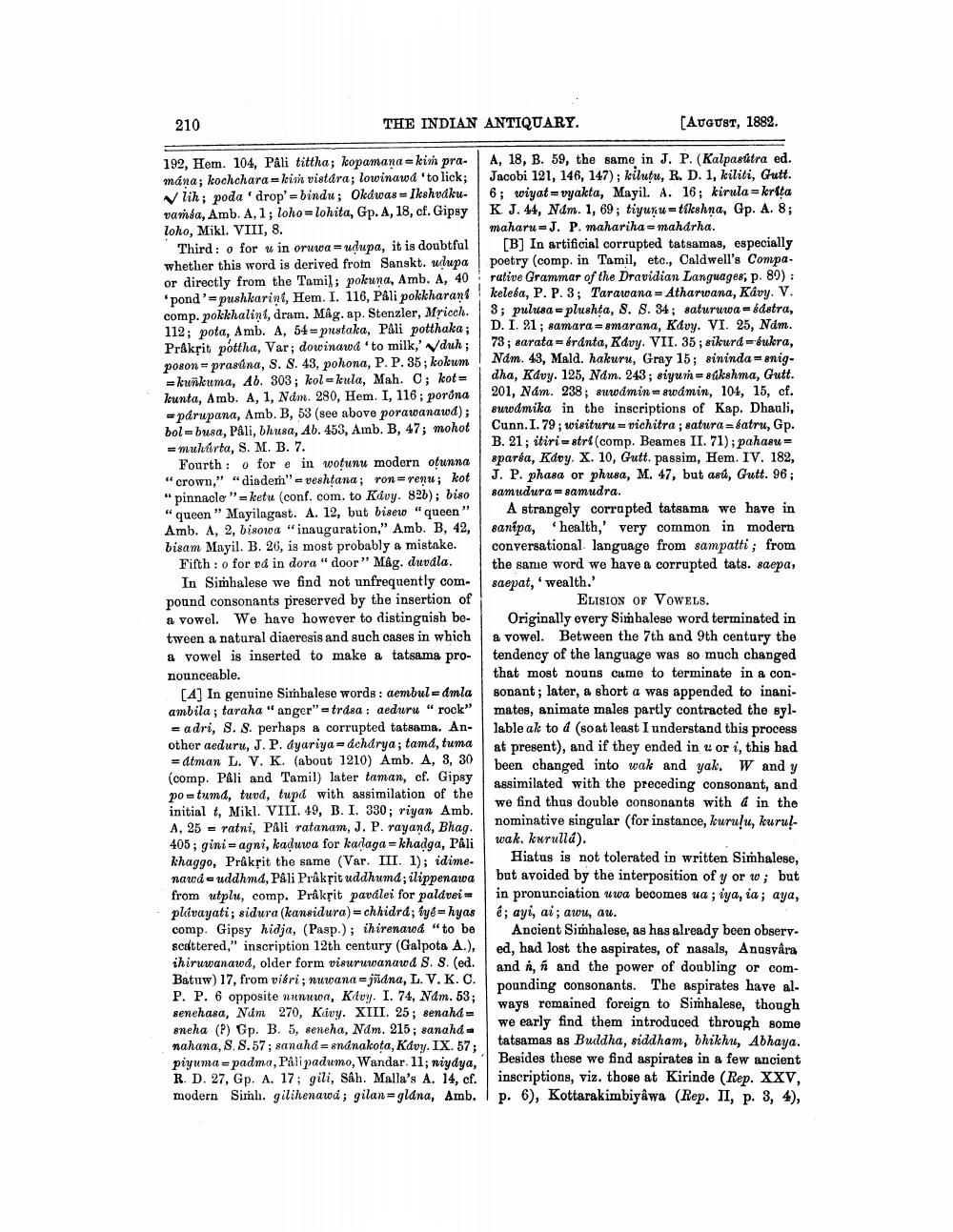________________
210
THE INDIAN ANTIQUARY.
[AUGUST, 1882
199 Hom. 104. Pali tittha: kopamana kivi pra- A, 18, B. 59, the same in J. P. (Kalpasutra ed. mána: kochchara-leiri vistara; lowinawd 'to lick; Jacobi 121, 146, 147); kihutu, R. D. 1, kiliti. Gutt.
✓ lih; poda'drop' = bindu; Okawas Ikshudku- 6; wiyat = vyakta, Mayil. A. 16; kirula = krita vamsa, Amb. A, 1; loholohita, Gp. A, 18, cf. Gipsy K J. 44, Nám. 1, 69; tiyunu=tikshna, Gp. A. 8; loho, Mikl. VIII, 8.
maharu - J. P. mahariha=mahdrha. Third : o for u in oruwarudupa, it is doubtful [B] In artificial corrupted tatsamas, especially whether this word is derived frotn Sanskt. udupa poetry (comp. in Tamil, etc., Caldwell's Compaor directly from the Tamil; pokuna, Amb. A, 40 rative Grammar of the Dravidian Languages, p. 89): * pond'pushkarint, Hem. I. 116, Pâli pokkharant keleba, P. P. 3; Tarawana - Atharwana, Kávy. V. comp. pokkhalint, dram. Mag. ap. Stenzler, Mricch. 3; pulusa = plushta, 8. 8. 34; saturuwa rédatra, 112; pota, Amb. A, 54 - prestaka, Pali potthaka; D.I. 21; samarasmarana, Kavy. VI. 25, Nam. Prakrit póttha, Var; dowinawa 'to milk,' duh; 78; sarata = franta, Kavy. VII. 35; sikurd -bukra, poson - prasúna, S. S. 43, pohona, P. P. 35; kokum! Nam. 43, Mald. hakuru, Gray 15; sininda=snig= kunkuma, 16. 303; kol-kula, Mah. C; kot - dha, Kavy. 125, Nam. 243; siyun= sdkshma, Gutt. leunta, Amb. A, 1, Nám. 280, Hem. I, 116; poróna
201, Nám. 238; suudmin= swamin, 104, 15, cf. #parupana, Amb. B, 53 (see above porawanawd); suwamika in the inscriptions of Kap. Dhauli, bol-busa, Pali, thusa, Ab. 453, Amb. B, 47; mohot
Cunn. I. 79; wisituru - vichitra ; satura - datru, Gp. = muharta, S. M. B. 7.
B. 21; itiri stri(comp. Beames II. 71); pahasuFourth : o for e in wotunu modern otunna
sparba, Kdoy. X. 10, Gutt. passim, Hem. IV. 182, “crown," "diadem" - veshtana; ron=renu; kot
J. P. phasa or phusa, M. 47, but asu, Gutt. 96; "pinnacle"-ketu (conf. com. to Kávy. 826); biso samudura = samudra. "queon " Mayilagast. A. 12, but bisew "queen" A strangely corrupted tatsama we have in Amb. A, 2, bisowa "inauguration," Amb. B, 42, sanipa, health,' very common in modern bisam Mayil. B. 26, is most probably a mistake. conversational language from sampatti; from Fifth : o for vá in dora "door" Mag. duvala. the sanie word we have a corrupted tats. saepa, In Siṁhalese we find not unfrequently com
saepat, 'wealth. pound consonants preserved by the insertion of
ELISION OF VOWELS. a vowel. We have however to distinguish be- Originally every Simbalese word terminated in tween a natural diaeresis and such cases in which a vowel. Between the 7th and 9th century the & vowel is inserted to make a tatsama pro- tendency of the language was so much changed nounceable.
that most nouns came to terminate in a con[4] In genuine Simhalese words : aembul=dmla sonant; later, a short a was appended to inaniambila; taraha "anger" - trdsa: aeduru "rock" mates, animate males partly contracted the syl
- adri, 8. 8. perhaps a corrupted tatsama. An- lable al to d (so at least I understand this process other aeduru, J.P. dyariya = acharya; tamd, tuma
at present), and if they ended in or i, this bad = dtman L. V. K. (about 1210) Amb. A, 3, 30
been changed into wak and yak. W and y (comp. Páli and Tamil) later taman, of. Gipsy
assimilated with the preceding consonant, and po = tuma, tuvd, tupd with assimilation of the initial t, Mikl. VIII. 49, B. I. 330; riyan Amb.
we find thus double consonants with a in the A, 25 = ratni, Páli ratanam, J. P. rayand, Bhag.
nominative singular (for instance, kuruļu, kurul405; gini= agni, kadura for kadaga=khadga, Pâli
wak, kurulla). khaggo, Prâksit the same (Var. III. 1); idime. Hiatus is not tolerated in written Sinhalese, navde uddhmd, Páli Praksit uddhumd; ilippenawa but avoided by the interposition of y or w; but from utplu, comp. Prakrit pavalei for paldvei in pronunciation uwa becomes ua ; iya, ia ; aya, plavayati; sidura (kansidura)= chhidrd; tyehyas é; ayi, ai, awu, au. comp. Gipsy hidja, (Pasp.); ihirenawa "to be Ancient Simhalese, as has already been observ. scattered," inscription 12th century (Galpota A.), ed, had lost the aspirates, of nasals, Anusvåra ihiruwanawd, older form visuruwanawd S. 8. (ed. and i, fi and the power of doubling or comBatuw) 17, from vibri; nuwana =jñana, L. V.K. C.
pounding consonants. The aspirates have al. P. P. 6 opposite nunuwa, Kavy. I. 74, Nám. 53; senehasa, Núm 270, Kivy. XIII. 25; senahá =
ways remained foreign to Sinhalese, though sneha (P) Gp. B. 5, seneha, Nam. 215; sanahd
we early find them introduced through some nahana, 8.8.57; sanahd = sndnakota, Kavy. IX. 57;
tatsamas as Buddha, siddham, bhikhri, Abhaya. piyuma = padma, Páli padumo, Wandar. 11; niyaya, Besides these we find aspirates in a few ancient R. D. 27, GP. A. 17; gili, sâh. Malla's A. 14, cf. inscriptions, viz. those at Kirinde (Rep. XXV, modern Simh. gilihenawá; gilan-glana, Amb. p. 6), Kottarakimbiyâwa (Rep. II, p. 3, 4),




